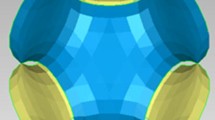Abstract
Predicting the mechanical properties of the 3-D scaffold using finite element method (FEM) simulation is important to the practical application of tissue engineering. However, the porous structure of the scaffold complicates computer simulations, and calculating scaffold models at the pore level is time-consuming. In some cases, the demands of the procedure are too high for a computer to run the standard code. To address this problem, the representative volume element (RVE) theory was introduced, but studies on RVE modeling applied to the 3-D scaffold model have not been focused. In this paper, we propose an improved FEM-based RVE modeling strategy to better predict the mechanical properties of the scaffold prior to fabrication. To improve the precision of RVE modeling, we evaluated various RVE models of newly designed 3-D scaffolds using FEM simulation. The scaffolds were then constructed using microstereolithography technology, and their mechanical properties were measured for comparison.
Similar content being viewed by others
Abbreviations
- Y:
-
Length scale in Global coordinate system
- y:
-
Length scale in Local coordinate system
- ε:
-
Scaling parameter
- i:
-
The current structural level
- i-1:
-
The next largest macroscopic level
- [M i ]:
-
Thei-th level of the local structure matrix
- [C i ]:
-
The stiffness of thei-th structural level
- VRVE :
-
RVE (representive volume element) volume
- S1:
-
A surface of RVE model that is fixed in thez-direction
- S2:
-
A surface on which a uniform displacement is applied
- Ez :
-
Effective Young’s modulus
- As1, As2 :
-
The areas of surfaces S1 and S2
- Lz :
-
The dimension of the RVE model in thez-direction
- F:
-
Reaction force
- σR :
-
Reaction stress
- d:
-
Displacement
- λ:
-
Wavelength
- R:
-
Gaussian half-width
- f:
-
Focal length
- Wo, min :
-
Gaussian half-width at the focal point
References
Fang, Z. and Sun, Wei., 2005, “Computeraided Characterization for Effective Mechanical Properties of Porous Tissue Scaffold,”Computer -aided Design, Vol. 37,pp. 65–72.
Fang, Z. and Sun, Wei., 2005, “Homogenization of Heterogeneous Tissue Scaffold: a Comparison of Mechanics, Asymptotic Homogenization, and Finite Element Approach,”J. of Bionics and Biomechanics, Vol. 2, pp. 17–29.
Hollister, S. J., Maddox, R. D. and Taboas, 2002, “Optimal Design and Fabrication of Scaffolds to Mimic Tissue Properties and Satisfy Biological Constraints,”Biomaterials, Vol. 23, pp. 95–103.
Hollister, S. J. and Kikuchi, N., 2005, “Homogenization Theory and Digital Imaging: A Basis for Studying the Mechanics and Design Principles of Bone Tissue,”Biotechnology and Bioengineering, Vol. 43, Issue 7, pp. 586–596.
Hutmacher, D. W., 2000, “Scaffolds in Tissue Engineering Bone and Cartilage,”Biomaterials, Vol. 21, pp. 29–43.
Ikuta, K. and Hirowatari, K., 1993, “Real Three-dimensional Microfabrication Using Stereo Lithography and metal Molding. In: Proceedings of the IEEE International Workshop on Micro Electro Mechanical Systems (MEMS ’93),”Fort Lauderdale, FL, 7–10 February 1993, pp. 42–47.
Kang, H.-W., Lee, I. H., Cho, D. -W. and Yun, W. S., 2005, “Development of Micro-bellows Actuator Using Micro-stereolithography Technology,”International Conference on Microand Nano-engineering 2005, 9D_01, Vienna, Austria, September 19–22.
Landers, R. and Mulhaupt, R., 2000, “Desktop Manufacturing of Complex Objects, Prototypes & Biomedical Scaffolds by Means of Computerassisted Design Combined with Computer-guided 3D Plotting of Polymers & Reactive Oligomers,”Macrol Mater Eng., Vol. 282, pp. 17–21.
Langer, R. and Joseph, P., 1993, “Tissue Engineering,”Science, Vol. 260, pp. 920–926.
Lee, I. H. and Cho, D.-W., 2002, “Microstereolithography Photopolymer Solidification Patterns for Various Laser Beam Exposure Conditions,”International Journal of Manufacturing and Technology, Vol. 22, pp. 410–416.
Lee, S. J. and Kim, B., 2005, “Development of Three-dimensional Scaffolds Using Micro-stereolithography Technology,”The 8th Annual Meeting of Tissue Engineering Society International, Shanghai, China, No. 269, October 22–25.
Lee, S. J., Kang, H. -W., Kim, Y. G. and Cho, D. -W., 2005, “Development of a Micro-bloodtyping System Using Micro-stereolithography,”Sensors and Materials, Vol. 17, No. 3, pp. 113–123.
Liu, Y. and Abramson, S., 2003, “Characterizing the Mechanical Properties of Poly-(Dte CaRbONate) Scaffold from the Finite Element Simulation of its Microtopology,”IEEE Conference, 22–23 March.
Vacanti, J. P. and Langer, R., 1999, “Tissue Engineering: the Design and Fabrication of Living Replacement Devices for Surgical Reconstruction and Transplantation,”Lancet., Vol. 354, pp. 32–34.
Author information
Authors and Affiliations
Corresponding author
Rights and permissions
About this article
Cite this article
Cheng, LS., Kang, HW. & Cho, DW. Improvement of the representative volume element method for 3-D scaffold simulation. J Mech Sci Technol 20, 1722–1729 (2006). https://doi.org/10.1007/BF02916276
Received:
Revised:
Issue Date:
DOI: https://doi.org/10.1007/BF02916276




